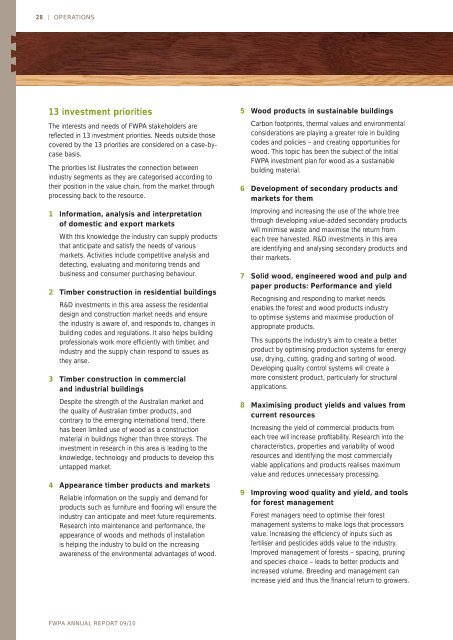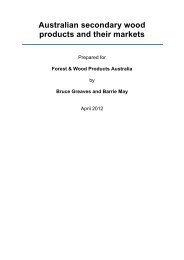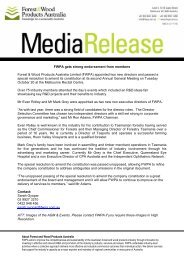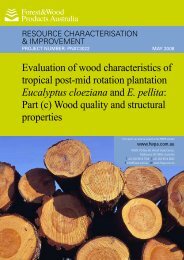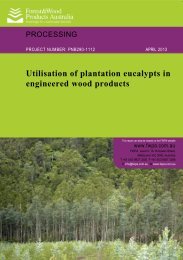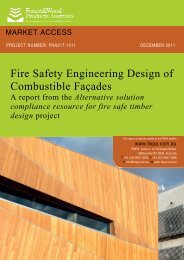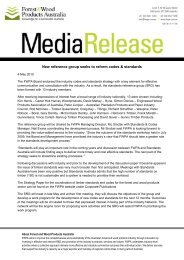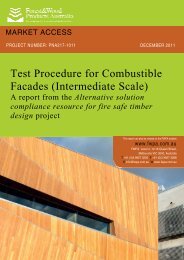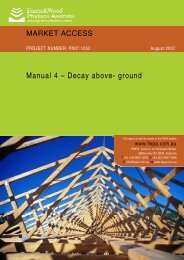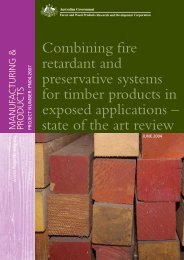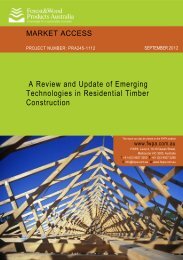ANNUAL REPORT 09/10 - Forest and Wood Products Australia
ANNUAL REPORT 09/10 - Forest and Wood Products Australia
ANNUAL REPORT 09/10 - Forest and Wood Products Australia
You also want an ePaper? Increase the reach of your titles
YUMPU automatically turns print PDFs into web optimized ePapers that Google loves.
28 | OPERATIONS<br />
13 investment priorities<br />
The interests <strong>and</strong> needs of FWPA stakeholders are<br />
refl ected in 13 investment priorities. Needs outside those<br />
covered by the 13 priorities are considered on a case-bycase<br />
basis.<br />
The priorities list illustrates the connection between<br />
industry segments as they are categorised according to<br />
their position in the value chain, from the market through<br />
processing back to the resource.<br />
1 Information, analysis <strong>and</strong> interpretation<br />
of domestic <strong>and</strong> export markets<br />
With this knowledge the industry can supply products<br />
that anticipate <strong>and</strong> satisfy the needs of various<br />
markets. Activities include competitive analysis <strong>and</strong><br />
detecting, evaluating <strong>and</strong> monitoring trends <strong>and</strong><br />
business <strong>and</strong> consumer purchasing behaviour.<br />
2 Timber construction in residential buildings<br />
R&D investments in this area assess the residential<br />
design <strong>and</strong> construction market needs <strong>and</strong> ensure<br />
the industry is aware of, <strong>and</strong> responds to, changes in<br />
building codes <strong>and</strong> regulations. It also helps building<br />
professionals work more effi ciently with timber, <strong>and</strong><br />
industry <strong>and</strong> the supply chain respond to issues as<br />
they arise.<br />
3 Timber construction in commercial<br />
<strong>and</strong> industrial buildings<br />
Despite the strength of the <strong>Australia</strong>n market <strong>and</strong><br />
the quality of <strong>Australia</strong>n timber products, <strong>and</strong><br />
contrary to the emerging international trend, there<br />
has been limited use of wood as a construction<br />
material in buildings higher than three storeys. The<br />
investment in research in this area is leading to the<br />
knowledge, technology <strong>and</strong> products to develop this<br />
untapped market.<br />
4 Appearance timber products <strong>and</strong> markets<br />
Reliable information on the supply <strong>and</strong> dem<strong>and</strong> for<br />
products such as furniture <strong>and</strong> fl ooring will ensure the<br />
industry can anticipate <strong>and</strong> meet future requirements.<br />
Research into maintenance <strong>and</strong> performance, the<br />
appearance of woods <strong>and</strong> methods of installation<br />
is helping the industry to build on the increasing<br />
awareness of the environmental advantages of wood.<br />
FWPA <strong>ANNUAL</strong> <strong>REPORT</strong> <strong>09</strong>/<strong>10</strong><br />
5 <strong>Wood</strong> products in sustainable buildings<br />
Carbon footprints, thermal values <strong>and</strong> environmental<br />
considerations are playing a greater role in building<br />
codes <strong>and</strong> policies – <strong>and</strong> creating opportunities for<br />
wood. This topic has been the subject of the initial<br />
FWPA investment plan for wood as a sustainable<br />
building material.<br />
6 Development of secondary products <strong>and</strong><br />
markets for them<br />
Improving <strong>and</strong> increasing the use of the whole tree<br />
through developing value-added secondary products<br />
will minimise waste <strong>and</strong> maximise the return from<br />
each tree harvested. R&D investments in this area<br />
are identifying <strong>and</strong> analysing secondary products <strong>and</strong><br />
their markets.<br />
7 Solid wood, engineered wood <strong>and</strong> pulp <strong>and</strong><br />
paper products: Performance <strong>and</strong> yield<br />
Recognising <strong>and</strong> responding to market needs<br />
enables the forest <strong>and</strong> wood products industry<br />
to optimise systems <strong>and</strong> maximise production of<br />
appropriate products.<br />
This supports the industry’s aim to create a better<br />
product by optimising production systems for energy<br />
use, drying, cutting, grading <strong>and</strong> sorting of wood.<br />
Developing quality control systems will create a<br />
more consistent product, particularly for structural<br />
applications.<br />
8 Maximising product yields <strong>and</strong> values from<br />
current resources<br />
Increasing the yield of commercial products from<br />
each tree will increase profi tability. Research into the<br />
characteristics, properties <strong>and</strong> variability of wood<br />
resources <strong>and</strong> identifying the most commercially<br />
viable applications <strong>and</strong> products realises maximum<br />
value <strong>and</strong> reduces unnecessary processing.<br />
9 Improving wood quality <strong>and</strong> yield, <strong>and</strong> tools<br />
for forest management<br />
<strong>Forest</strong> managers need to optimise their forest<br />
management systems to make logs that processors<br />
value. Increasing the effi ciency of inputs such as<br />
fertiliser <strong>and</strong> pesticides adds value to the industry.<br />
Improved management of forests – spacing, pruning<br />
<strong>and</strong> species choice – leads to better products <strong>and</strong><br />
increased volume. Breeding <strong>and</strong> management can<br />
increase yield <strong>and</strong> thus the fi nancial return to growers.


